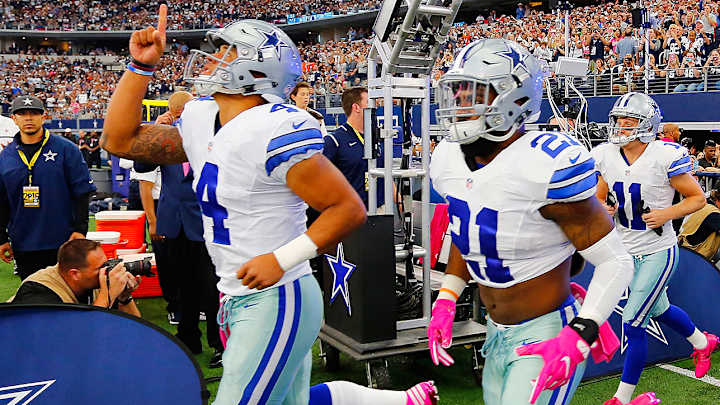The 'Boys Are Back: How the Cowboys rescued this NFL season just in time

Phenologically speaking, each NFL season begins in summer and ends in winter. But opening week in 2016 could not have seemed a fecund moment to the muckety-mucks on Park or Madison Avenues. Peyton Manning had retired, so the defending champion Broncos trotted out a second-year seventh-rounder at quarterback, Trevor Siemian. The league’s biggest star, Tom Brady, had been banished from New England’s first four games, due process having postponed the commissioner’s May ’15 disciplinary caprice for a year. (Who even remembered what all that had been about?) The most famous player on the league’s most popular team—Dallas quarterback Tony Romo—was also sidelined, as he was recovering from a preseason back injury.
Things didn’t get much better in the first few weeks of the season. Television ratings were down; defenders were knocking around reigning MVP Cam Newton; and the league’s most talked-about player, 49ers quarterback Colin Kaepernick, was blamed for everything wrong with the sport despite residing on the bench for nearly every single snap of San Francisco's first five games.
What a difference two months makes. Despite that Deflategate suspension, Brady is a leading candidate for MVP. Ratings have rebounded. And, best of all for a league craving positive story lines, the Cowboys overcame Romo’s absence and will enter the playoffs as not just America's favorite team but maybe its best one too. For the league and its partners, spring came in November with all the familiar crocuses and daffodils. Just think how pastoral these playoffs could be!
A Breath of Fresh Heir: Stephen Jones following in the shadow cast by his father
Call Nov. 13 the equinox. Dallas had started the season 7–1, with wins at Washington and Green Bay and an overtime defeat of Philadelphia at home. But the Cowboys were still anchored by rookies at quarterback (Dak Prescott) and running back (Ezekiel Elliott), without the sort of victory that dominates a whole week’s TV chatter. That day they were in Pittsburgh to face one of their oldest rivals. Steelers quarterback Ben Roethlisberger led a 75-yard touchdown drive for a 30–29 lead with 42 seconds left. Prescott led his team to the outer edge of field goal range with 15 seconds remaining. Then came the season’s defining handoff—Prescott to Elliott, with the Cowboys’ superlative offensive line blocking for nothing more than a halfback dive. Elliott sprinted 32 yards through Pittsburgh’s remaining defenders for a game-winning touchdown, and Dallas’s status as America’s Team was once again unimpeachable.
It was 1979 when an NFL Films producer tossed that phrase into John Facenda’s voice-over script for the previous season’s highlights tape. The ’78 Cowboys, defending champions, had made it to a then NFL-record fifth Super Bowl, and though they lost to the Steelers, Dallas’s prospects still seemed brighter than those of any other team.
Sportswriters and announcers took the term and ran with it. Perhaps the appellation stuck because it wasn’t such an overstatement. A 1979 Washington Post story reported that the Cowboys that year accounted for 29% of all teams’ merchandise sales (Pittsburgh was No. 2 at 8%), and Dallas Cowboys Weekly was the second-largest weekly sports publication in America (behind, ahem, this one). In the 15 Harris Polls since 1998 asking fans to pick their favorite NFL team, Dallas has been voted No. 1 10 times, including in the most recently released edition, in 2015.
That’s some feat, because until this year the youngest generation of football fans knew the Cowboys as nothing other than a stupendously wealthy franchise (Forbes ranks them No. 1 in sports at $4 billion) with a preposterously big stadium. After winning three Super Bowls in four seasons in the mid-1990s, Dallas followed up with 19 seasons, starting in 1997, in which it won all of two playoff games. The Cowboys’ .500 winning percentage from ’97 through 2015 ranked 16th in the sport, worse than the Jets and barely better than the Chargers. America’s Team? No, no, that had to be the peerless Patriots, on-the-nose symbolism be damned. Or maybe the Seahawks, who have risen through the league with outspoken stars playing a loud game. Or the storied Packers, working on a string of eight straight playoff appearances. Which world economy ranks No. 16 in GDP? Hmm ... how does “Indonesia’s Team” sound?
NFL Picks: Can Cowboys, Chiefs slow soaring offenses of Packers, Steelers on Sunday?
This year, however, the Cowboys have been as potent as they are popular, leading the NFL in rushing yards and TV ratings, attendance and merchandise sales too. Nostalgia pumps through the sports world, and fans fall hardest for stories, like Dallas’s dominance, that remind them of the ones they heard when they were young. The NFL likes those stories too, since casual fans can more easily understand the Cowboys than, say, the Panthers, as the NFL's center of gravity.
A lot of ink is spent chronicling the existential threats facing pro football, like head injuries and cord-cutting cable subscribers. Much of the doomsday-prognosticating could turn out one day to be true. But in 2017, the Cowboys are the NFC’s No. 1 seed. They have done it with a pair of Pro Bowl rookies, yes, but also with elite run blocking—how old-fashioned. Are we ever speeding forward as fast as we think we are? America’s Team, indeed.
